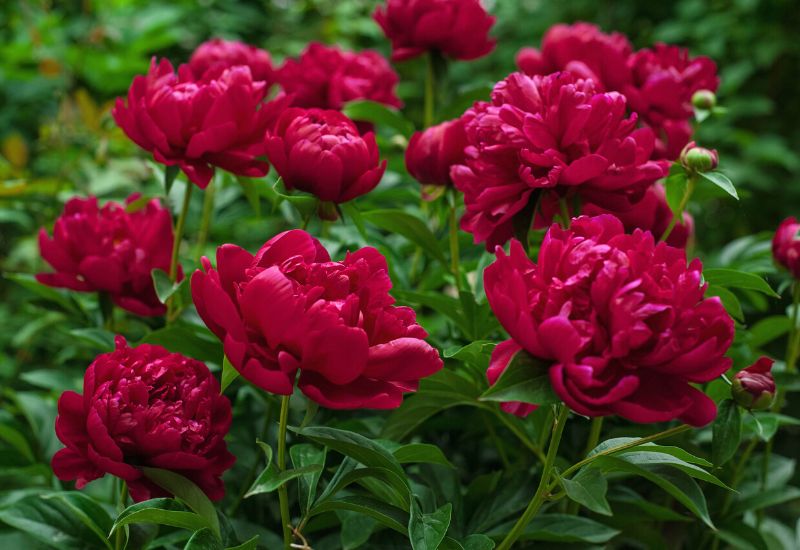
Known for their showy, colorful and globular blooms, dahlias share some similar traits with many other species, from peonies to marigolds and even some chrysanthemums, dahlias have many look-alikes flowers.
Then, of course, there are single varieties, and here the range of varieties grows to asters and coreopsis.
Having said this, there are also many differences, not just in the blossoms and their colors, but also in foliage, size and growing, soil and sunlight conditions or climate zones.
But maybe the most important issue is that dahlias are late bloomers: they keep you company from the hottest day of the year to when leaves turn golden and red, before falling.
Luckily, other similar annuals and perennials with dahlia-like flowers are easy to find and simple to grow, and they will open their blooms much earlier in the season, so you don’t need to wait for “the real thing”…
Check out our list of flowers that look like sunflowers to pick radiant, easy-to-grow options for your home and backyard.
So, the flowers we want to show you all look like dahlias, but they are also very different, and if you want to find out why, you will have to read on!
Why Choose a Flower That Looks Like a Dahlia
You may wonder, “Why not go for the real thing, a dahlia, and choose a similar flower?” Good question… To start with, you may simply like their shape and overall look… but there are more reasons…
For example, you may wish to have some continuity in shape within your borders of flower beds.
Then again, your garden may not have the right growing conditions for dahlias, in which case, you may wish to replace them with lookalikes.
Yet again, you may want a dahlia looking bloom but the size of the plant and flower you are after are different… Finally, it may just be a personal curiosity, which we wish to satisfy, and so… Let’s see which varieties look like, but are not dahlias!
12 Flowers That Really Look Like Dahlias
We have split the flowers that look like dahlias into two: those that resemble the double varieties, and others that are similar to single flowered ones.
Here are 12 radiant, easy-to-grow options if you want dahlia-like flowers in your garden.
Flower’s That Look Like Double Dahlias
Double dahlias are the best known and most popular varieties; their globular shape and large, colorful blooms are very showy and even architectural, often thanks to the regular arrangement of the petals.
And some flowers have a similar appearance, but never really the exact same – here they are!
1. Double Peonies (Paeonia spp.)
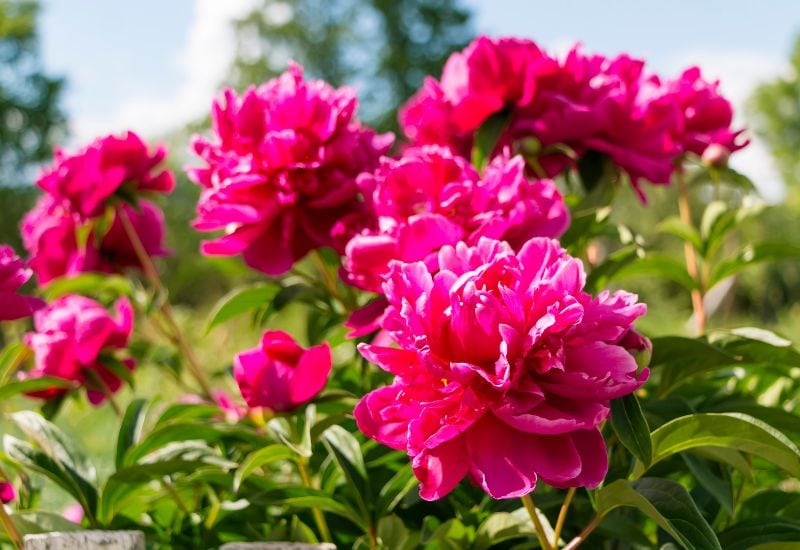
Looking at the famous globular blooms of dahlias, we can see strong similarities with double peonies.
There are many varieties that fit this description, from the champagne yellow ‘Prairie Charm’ to ‘Pink Derby’ and the snow white ‘Bowl of Cream’ (Paeonia lactifolia ‘Bowl of Cream’).
However, the petals are never arranged as regularly and sculpturally as they are in pompon dahlias like the fabulous ‘Andrea Dawson’ or the flaming red ‘Brown Sugar’.
On the other hand, the wild and unkempt looking ‘Cora Stubbs’ looks like a collarette variety, and ‘Red Emperor’ may even remind you of a semi cactus dahlia!
Of course, peonies have different foliage, less glossy, but very finely textured, which makes them ideal for borders, while their blooms are only suitable to informal garden styles, unlike some dahlias that can fit well in formal settings.
2. Double Zinnias (Zinnia spp.)
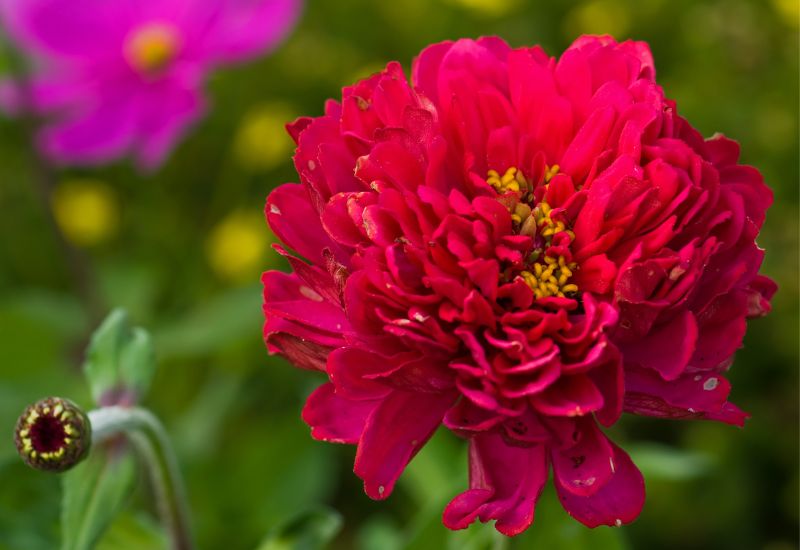
Of all the flowers in the world, those that look most like double, even pompon dahlias are double zinnias.
In fact, some varieties almost have the same regular arrangement of petals as we find in dahlias, like the huge ‘Binary’s Giant Golden Yellow’ whose blooms reach 6 inches across (15 cm), or the equally massive ‘Binary’s Giant Lilac’ but maybe the prize for the fullest blossom of all goes to the magenta pink ‘Miss Willmott’ which is 3 inches in diameter (7.5 cm).
And the cultivar ‘Inca’ could well be confused for a cactus dahlia, with its long, pointed and slightly curving petals.
The foliage of all these varieties is herbaceous and pointed, mid to dark green, which makes an important difference.
With a similar color range, excluding violet and blue tones, double zinnias can replace dahlias in flower beds and borders, or you could just mix them together for continuity in shape. What is more, zinnias are annuals, and they can grow in much colder regions than dahlias.
3. African Marigold (Tagetes Erects)
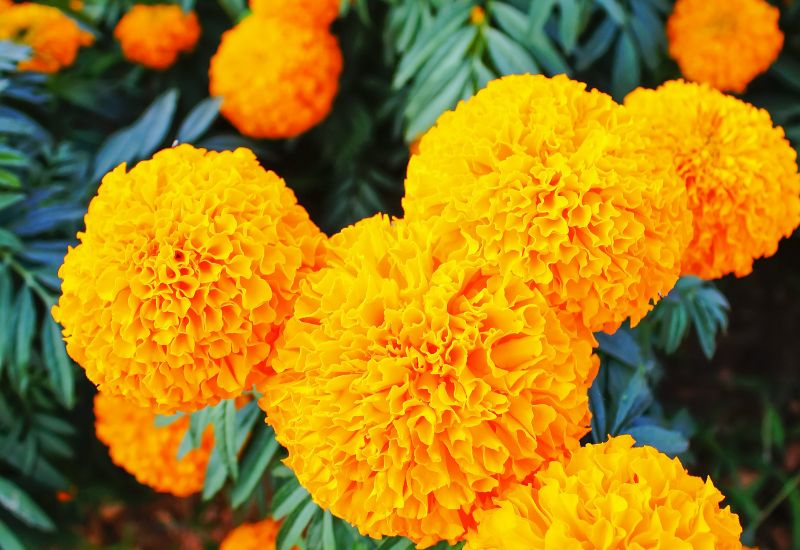
Yet another annual with globular blooms that can remind you of dahlias is African marigold.
The blooms are not perfect spheres though, as they are flattened at the top, and while they are packed with petals, there are fringed and curly.
What is more, you only have a small color range, white, yellow or orange, and the flowers are only 2 to 4 inches across (5.0 to 10 cm).
With super finely textured foliage, however, they are quite decorative and in addition to this, they keep troublesome bugs away from your beds and borders. Yes, because insects literally detest their strong smell.
Maybe this is in fact the best use of African marigold: to grow it with your dahlias, so that these plants don’t get infested, given that their soft stems and leaves can be damaged very easily.
4. Double Anemones (Anemone coronaria)

Many double anemone varieties have blooms that can look like those of dahlias. For example, the blue with a violet shade ‘Lord Lieutenant’ or the candid white ‘Mount Everest’.
However, with these, you still see the central disk, and the petals are not as regular as in dahlias, nor do they reach the same flower size, stopping at a modest 2.5 inches (6.0 cm)..
But maybe the most intriguing is the flaming red ‘The Governor’ which could be confused with a collarette dahlia, thanks to the two shapes of its petals, broad at the back, thin and arching inward in the middle.
Alike in plant size and suitable for similar growing conditions, these anemones can fit well with the shapes of dahlia blooms, but they add much more finely textured foliage, which can be a great addition to your herbaceous border.
What is mire, they blossom earlier than dahlias, so you can have an advance taste of what your garden will look like when they bloom, though on a smaller scale.
5. Double Chrysanthemums (Chrysanthemum spp.)
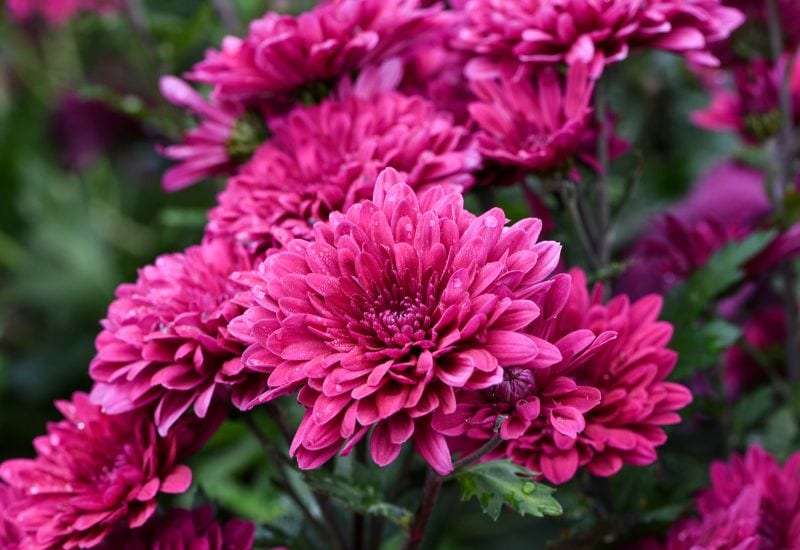
Chrysanthemums are impressive bloomers and some double varieties really look like dahlias.
Do you want some examples? The deep pink ‘Grandchild’, with blooms that reach 5 inches across (12 cm), the smaller and yellow orange ‘Foreglow Bronze’ – very energetic! – as well as ‘Ruby Mound’ and even the cerise red ‘Jolly Cheryl’.
There are many more, of course out of the thousands of varieties. However, one that is jaw dropping and looks like a semi cactus dahlia is ‘Matchsticks’… it has long and folded petals, and they start off with a bright shade of yellow at the center, but show drop like patches of ruby red at the tips! Quite an eye catcher!
If you want to thicken and strengthen the effect of globular dahlias late in the season, double chrysanthemums are a good choice for beds and borders in any informal garden.
6. Gerbera Daisy (Gerbera jamesonii and Gerbera garvinea)
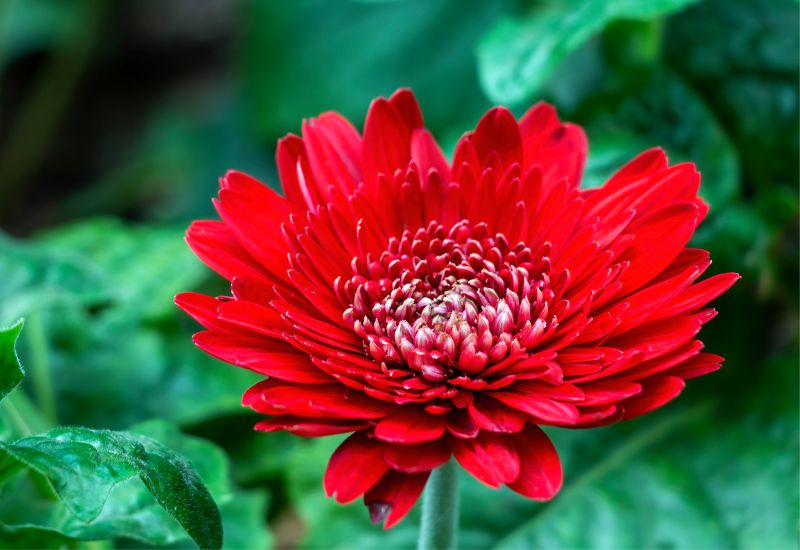
Some gerbera daisies can look quite a bit like some double dahlias, especially collarette varieties.
For example the garvinea cultivar ‘Sweet Memories’ has smaller, pale pink petals near the center, which contrast beautifully with the rich pink reddish outer ones, which are much bigger.
You get a similar effect from the exquisitely colored ‘Mega Revolution Salmon Rose’, though this unusual and delicate shade is contrasted by a lime yellow center.
But the one you want for a psychedelic effect is the jamesonii ‘Two Zone Orange’… It has super bright yellow petals with flaming red tips, and it looks like it shines of a light of its own.
The large foliage at the base of gerbera daisies make them ideal for containers, and the fact that they bloom all year round gives you a dahlia like look even when no real dahlia is in sight!
7. Persian Buttercups (Ranunculus asiaticus)
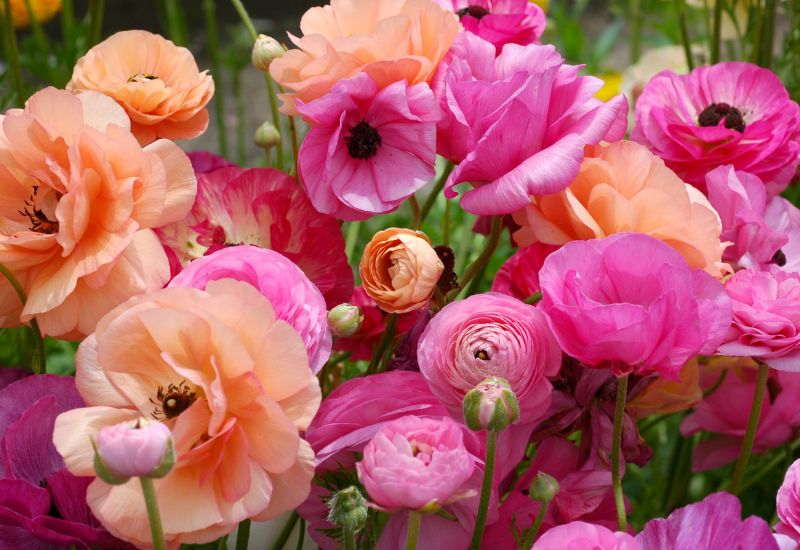
Ok, the petals of sweet looking Persian buttercups are broad, unlike those of dahlias, but the overall globular, almost spherical shape of the bloom is quite similar indeed.
Loved in bouquets, there are quite a few varieties to choose from, including the pink ‘Clone Pompon Hemione’, one of the most romantic flowers ever, the snow colored ‘Delano White’ the flaming ‘Delano Red’ and ‘Tecolote Red’ or the bright golden ‘Delano Yellow’.
Alternatively, a species that looks really like miniature pom pom dahlia is meadow buttercup (Ranunculus acris), especially the yellow cultivar ‘Flore Pleno’.
With long stems and finely cut leaves, these charming bulbous perennials offer great elegance and harmony.
Starting their bloom earlier than dahlias and smaller in size, you could grow Persian or meadow buttercups as precursor to the more showy blooms of dahlias later in the season, in beds, birders or as cut flowers.
8. African Daisy 4D Series (Osteospermum ‘4D Series’)
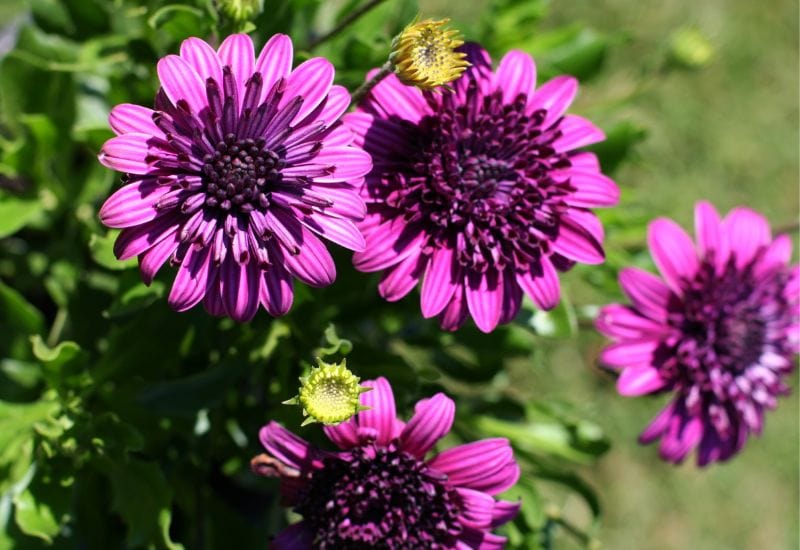
The 4D series of African daisy cultivars is quite unique insofar as the blooms do look like collarette dahlias.
The fact is that they have flat outer petals and then another round clump in the middle with smaller tubular ones! Blooming throughout the whole season, there are quite a few varieties that could interest you…
For example, the canary yellow with golden central petals ‘Sunburst’, or the pale blue and violet ‘Silver’, the white and mauve ‘Violet Ice’ or the just off white and purple ‘Berry White’.
These delicate chromatic combinations are a real asset to any garden, really. And the lush green foliage makes the perfect backdrop for this long lasting floral display.
Sumptuous and showy, the African daisies of the 4D series will give you amazing blooms till frost and they require very low maintenance. They are also ideal for window boxes and containers, unlike many dahlias.
Flowers That Look Like Single Dahlias
Single dahlias are less unique than double ones, and there are quite a few lookalikes flowers that mimic the flower’s appearance.
But we picked the ones that are really more comparable, more alike, out of them all, and here they are.
9. Chocolate Cosmos (Cosmos astrosanguineus)
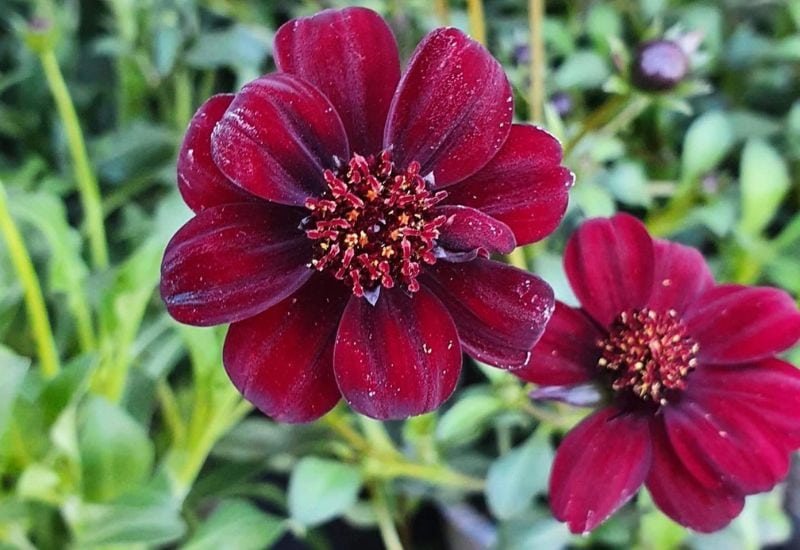
Called chocolate cosmos because of its smell, it looks like single daisies and it brings to your garden a deep velvety red color that makes its display really unique.
The 8 petals are broad and rounded at the tips, with grooves that run along their length. These come on long and this stems, and they are 2 inches across.
The leaves are pinnate, with deep lobes and unusual petioles, because they are winged. Very graceful and generous with its blossom.
This means that butterflies and pollinators will come to visit your land, make it fertile and more lively as well.
Perfect for cottage gardens, chocolate cosmos will also look great in any other informal bed or border, or, if you want to enjoy its sweet smell close by, you can grow it in containers.
10. Japanese Anemone (Eriocapitella hupehensis)
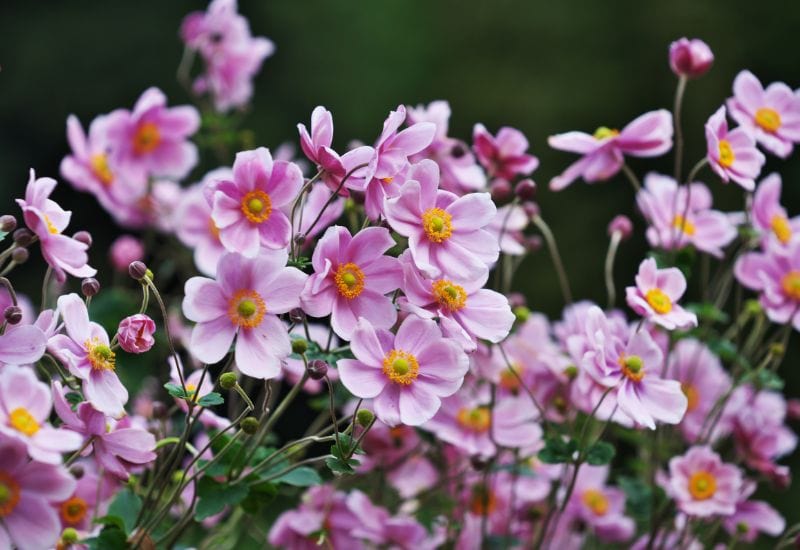
Called Japanese anemone, thus flower us actually from China, and this is not the only confusion this herbaceous perennial has caused: in fact you could mistake it for a single dahlia!
It has broad and well proportioned petals with rounded and dented tips, around an center that is canary and golden yellow.
The color ranges from white to deep pink, with many shades in between and bicolor varieties as well.
Some even have a lovely and delicate pastel violet blush on the outside of the blooms! Coming on thin, long and fragile looking stems, they appear to hover in the air just above the dense and lush mid to deep green foliage.
Ideal for naturalized and very informal gardens, Japanese anemone will easily adapt to grow under trees and in wet soil, where real dahlias would suffer and fail to bloom.
11. Black-Eyed Susan (Rudbeckia hirta)
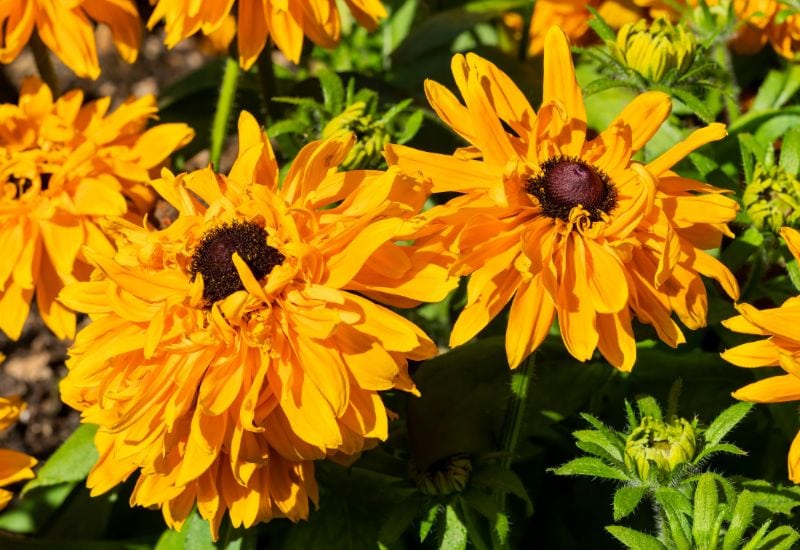
Black-eyed Susan is similar to many varieties of single dahlias, including the astonishing ‘Moon fire’ with a dark purple center and petals that are bright red around it and then cream.
This effect is taken up very well by many species and cultivars of Rudbeckia, including ‘Sumerian Orange’ which plays with different shades between red and yellow, or the classic ‘Autumn Colors’, with rust to bronze petals that turn into a dark red disk in the middle.
Winner of the Award of Garden Merit by the Royal Horticultural Society, this is one of the most iconic varieties, with blooms that reach 5 inches across! Hovering above the green foliage on thin stems, these put on a very dramatic display that lasts till frost!
Unlike dahlias, black-eyed Susan is cold hardy, so suitable to gardens in temperate and even cool regions, and while it is a short lived perennial, you can also grow it as an annual in beds, borders or containers.
12. Painted Daisy (Chrysanthemum carinatum)
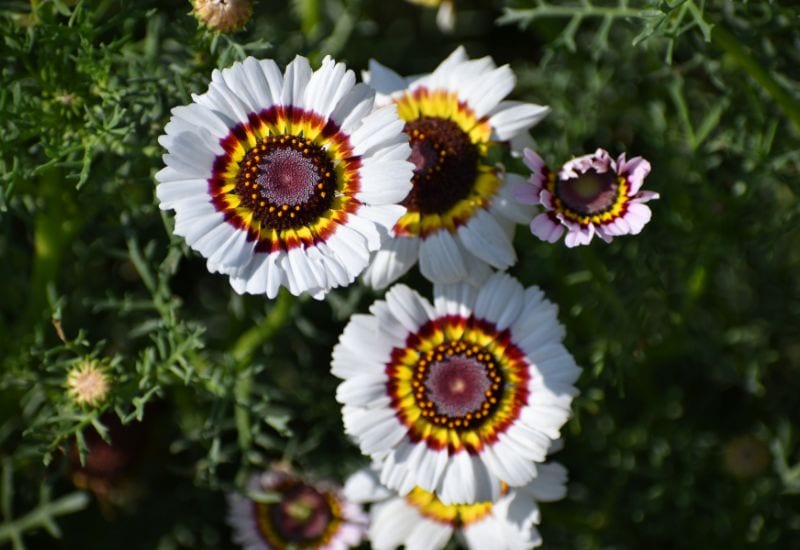
North Africa has given us a formidable annual that looks like a very artistic dahlia: painted daisy.
While it is a chrysanthemum for some botanists (for others it is called Similia carinatum) it blooms in summer, but what makes it outstanding is the colors it displays in its blooms, that reach 3 inches across (7.5 cm).
Starting from the center, you will see pink disk flowers, with a ring of yellow ones that look like stars against a backdrop of deep purple.
Then the petals (or ray flowers) are golden yellow at the base, changing to dark red on the plum scale and then magenta before you see the snow white that makes up most of them!
However, not all have exactly the same color pattern, as they are quite creative… Coming on a dense shrubby plant with green foliage, these are real show stoppers!
Used in mass planting, painted daisy is a real wonder, and because it is an annual, you don’t need to worry about living in a cold region, as you would with dahlias.
Like Dahlias, But Not Dahlias
Each of the flowers you have seen has its own personality, but they do share something in common, these are the varieties that, despite not being real dahlias, in many ways look like them!

Written By
Margie Fetchik
Margie and Arkansas native has an extensive background in gardening and landscaping. For the last 40 years, Margie has called the Colorado Rocky Mountains her home. Here she and her husband of 36 years raised three kids and owned a successful landscaping company. Margie has a CSU Master Gardener certification. She specialized in garden design & installation, perennial gardens, turf grasses & weeds, flower containers, and the overall maintenance of allHOA, commercial and residential accounts. She and her husband now reside in Denver and are excited about the new experiences’ city life holds.

I like what I’m seeing. You showcase some lovely flowers.